α-Borophene Nanoribbons: Edge-Dependent Metallic and Magnetic Properties for Low-Dimensional Nanoelectronics
Abstract
1. Introduction
2. Computational Methods
3. Results
4. Summary and Conclusions
Supplementary Materials
Author Contributions
Funding
Institutional Review Board Statement
Informed Consent Statement
Data Availability Statement
Acknowledgments
Conflicts of Interest
References
- Penev, E.S.; Bhowmick, S.; Sadrzadeh, A.; Yakobson, B.I. Polymorphism of Two-Dimensional Boron. Nano Lett. 2012, 12, 2441–2445. [Google Scholar] [CrossRef]
- Zhang, Z.; Yang, Y.; Gao, G.; Yakobson, B.I. Two-Dimensional Boron Monolayers Mediated by Metal Substrates. Angew. Chem. 2015, 127, 13214–13218. [Google Scholar] [CrossRef]
- Gonzalez Szwacki, N.; Sadrzadeh, A.; Yakobson, B.I. B 80 Fullerene: An Ab Initio Prediction of Geometry, Stability, and Electronic Structure. Phys. Rev. Lett. 2007, 98, 166804. [Google Scholar] [CrossRef] [PubMed]
- Zhai, H.-J.; Zhao, Y.-F.; Li, W.-L.; Chen, Q.; Bai, H.; Hu, H.-S.; Piazza, Z.A.; Tian, W.-J.; Lu, H.-G.; Wu, Y.-B.; et al. Observation of an All-Boron Fullerene. Nat. Chem. 2014, 6, 727–731. [Google Scholar] [CrossRef]
- Singh, A.K.; Sadrzadeh, A.; Yakobson, B.I. Probing Properties of Boron α-Tubes by Ab Initio Calculations. Nano Lett. 2008, 8, 1314–1317. [Google Scholar] [CrossRef]
- Tang, H.; Ismail-Beigi, S. Novel Precursors for Boron Nanotubes: The Competition of Two-Center and Three-Center Bonding in Boron Sheets. Phys. Rev. Lett. 2007, 99, 115501. [Google Scholar] [CrossRef]
- Liu, X.; Li, Q.; Ruan, Q.; Rahn, M.S.; Yakobson, B.I.; Hersam, M.C. Borophene Synthesis beyond the Single-Atomic-Layer Limit. Nat. Mater. 2022, 21, 35–40. [Google Scholar] [CrossRef]
- Li, Q.; Aklile, E.B.; Tsui, A.; Hersam, M.C. Progress and Future Directions in Borophene Research. Nat. Chem. 2025, 17, 642–652. [Google Scholar] [CrossRef]
- Mannix, A.J.; Zhou, X.-F.; Kiraly, B.; Wood, J.D.; Alducin, D.; Myers, B.D.; Liu, X.; Fisher, B.L.; Santiago, U.; Guest, J.R.; et al. Synthesis of Borophenes: Anisotropic, Two-Dimensional Boron Polymorphs. Science 2015, 350, 1513–1516. [Google Scholar] [CrossRef] [PubMed]
- Feng, B.; Zhang, J.; Zhong, Q.; Li, W.; Li, S.; Li, H.; Cheng, P.; Meng, S.; Chen, L.; Wu, K. Experimental Realization of Two-Dimensional Boron Sheets. Nat. Chem. 2016, 8, 563–568. [Google Scholar] [CrossRef] [PubMed]
- Zhang, Z.; Penev, E.S.; Yakobson, B.I. Polyphony in B Flat. Nat. Chem. 2016, 8, 525–527. [Google Scholar] [CrossRef]
- Zhang, Z.; Penev, E.S.; Yakobson, B.I. Two-Dimensional Boron: Structures, Properties and Applications. Chem. Soc. Rev. 2017, 46, 6746–6763. [Google Scholar] [CrossRef]
- Li, D.; Gao, J.; Cheng, P.; He, J.; Yin, Y.; Hu, Y.; Chen, L.; Cheng, Y.; Zhao, J. 2D Boron Sheets: Structure, Growth, and Electronic and Thermal Transport Properties. Adv. Funct. Mater. 2020, 30, 1904349. [Google Scholar] [CrossRef]
- Yang, X.; Dou, X.; Rouhanipour, A.; Zhi, L.; Räder, H.J.; Müllen, K. Two-Dimensional Graphene Nanoribbons. J. Am. Chem. Soc. 2008, 130, 4216–4217. [Google Scholar] [CrossRef]
- Son, Y.-W.; Cohen, M.L.; Louie, S.G. Energy Gaps in Graphene Nanoribbons. Phys. Rev. Lett. 2006, 97, 216803. [Google Scholar] [CrossRef] [PubMed]
- Izadi Vishkayi, S.; Bagheri Tagani, M. Edge-Dependent Electronic and Magnetic Characteristics of Freestanding β12-Borophene Nanoribbons. Nano-Micro Lett. 2018, 10, 14. [Google Scholar] [CrossRef] [PubMed]
- Ding, Y.; Yang, X.; Ni, J. Electronic Structures of Boron Nanoribbons. Appl. Phys. Lett. 2008, 93, 043107. [Google Scholar] [CrossRef]
- Li, G.Q. The Transport Properties of Boron Nanostructures. Appl. Phys. Lett. 2009, 94, 193116. [Google Scholar] [CrossRef]
- Saxena, S.; Tyson, T.A. Insights on the Atomic and Electronic Structure of Boron Nanoribbons. Phys. Rev. Lett. 2010, 104, 245502. [Google Scholar] [CrossRef]
- Ghasemzadeh, F.; Farokhnezhad, M.; Esmaeilzadeh, M. Thermal Spin Filtering and Spin-Dependent Seebeck Effect in α-Borophene Nanoribbons. J. Phys. Chem. C 2024, 128, 21108–21116. [Google Scholar] [CrossRef]
- Vatankhahan, A.; Movlarooy, T. DFT Study of High-Curie-Temperature Ferromagnetism in A-borophene Nanoribbons for Spintronic Applications. Adv. Theory Simul. 2023, 6, 2200925. [Google Scholar] [CrossRef]
- Liu, M.; Artyukhov, V.I.; Yakobson, B.I. Mechanochemistry of One-Dimensional Boron: Structural and Electronic Transitions. J. Am. Chem. Soc. 2017, 139, 2111–2117. [Google Scholar] [CrossRef] [PubMed]
- Gonzalez Szwacki, N.; Tarkowski, T.; Majewski, J.A. Structure and Energetics of Fragments of the Planar α and β Boron Sheets. Acta Phys. Pol. A 2016, 129, A-148–A-149. [Google Scholar] [CrossRef]
- Hu, P.-J.; Liang, Z.-R.; Sun, J.-W.; Fang, T.-F.; Guo, A.-M.; Sun, Q.-F. Contact Effects on Electron Transport along Disordered Borophene Nanoribbons with Line Defects. Phys. Rev. B 2024, 109, 165437. [Google Scholar] [CrossRef]
- Hu, P.-J.; Wang, S.-X.; Chen, X.-F.; Liang, Z.-R.; Fang, T.-F.; Guo, A.-M.; Xu, H.; Sun, Q.-F. Resonant Tunneling in Disordered Borophene Nanoribbons with Line Defects. Npj Comput. Mater. 2022, 8, 131. [Google Scholar] [CrossRef]
- Seenithurai, S.; Chai, J.-D. Electronic Properties of Linear and Cyclic Boron Nanoribbons from Thermally-Assisted-Occupation Density Functional Theory. Sci. Rep. 2019, 9, 12139. [Google Scholar] [CrossRef]
- Qiu, L.; Mu, Y.; Kim, S.Y.; Ding, F. Self-Termination of Borophene Edges. JACS Au 2024, 4, 116–124. [Google Scholar] [CrossRef]
- Tian, J.; Xu, Z.; Shen, C.; Liu, F.; Xu, N.; Gao, H.-J. One-Dimensional Boron Nanostructures: Prediction, Synthesis, Characterizations, and Applications. Nanoscale 2010, 2, 1375. [Google Scholar] [CrossRef]
- Xu, T.T.; Zheng, J.-G.; Wu; Nicholls, A.W.; Roth, J.R.; Dikin, D.A.; Ruoff, R.S. Crystalline Boron Nanoribbons: Synthesis and Characterization. Nano Lett. 2004, 4, 963–968. [Google Scholar] [CrossRef]
- Li, Q.; Wang, L.; Li, H.; Chan, M.K.Y.; Hersam, M.C. Synthesis of Quantum-Confined Borophene Nanoribbons. ACS Nano 2024, 18, 483–491. [Google Scholar] [CrossRef]
- Van Setten, M.J.; Giantomassi, M.; Bousquet, E.; Verstraete, M.J.; Hamann, D.R.; Gonze, X.; Rignanese, G.-M. The PseudoDojo: Training and Grading a 85 Element Optimized Norm-Conserving Pseudopotential Table. Comput. Phys. Commun. 2018, 226, 39–54. [Google Scholar] [CrossRef]
- Giannozzi, P.; Baroni, S.; Bonini, N.; Calandra, M.; Car, R.; Cavazzoni, C.; Ceresoli, D.; Chiarotti, G.L.; Cococcioni, M.; Dabo, I.; et al. QUANTUM ESPRESSO: A Modular and Open-Source Software Project for Quantum Simulations of Materials. J. Phys. Condens. Matter 2009, 21, 395502. [Google Scholar] [CrossRef]
- Momma, K.; Izumi, F. VESTA 3 for Three-Dimensional Visualization of Crystal, Volumetric and Morphology Data. J. Appl. Crystallogr. 2011, 44, 1272–1276. [Google Scholar] [CrossRef]
- Brandbyge, M.; Mozos, J.-L.; Ordejón, P.; Taylor, J.; Stokbro, K. Density-Functional Method for Nonequilibrium Electron Transport. Phys. Rev. B 2002, 65, 165401. [Google Scholar] [CrossRef]
- Papior, N.; Lorente, N.; Frederiksen, T.; García, A.; Brandbyge, M. Improvements on Non-Equilibrium and Transport Green Function Techniques: The next-Generation Transiesta. Comput. Phys. Commun. 2017, 212, 8–24. [Google Scholar] [CrossRef]
- Paulsson, M.; Brandbyge, M. Transmission Eigenchannels from Nonequilibrium Green’s Functions. Phys. Rev. B 2007, 76, 115117. [Google Scholar] [CrossRef]
- Frederiksen, T.; Paulsson, M.; Brandbyge, M.; Jauho, A.-P. Inelastic Transport Theory from First Principles: Methodology and Application to Nanoscale Devices. Phys. Rev. B 2007, 75, 205413. [Google Scholar] [CrossRef]
- Norouzi, F.; Farokhnezhad, M.; Esmaeilzadeh, M.; Szafran, B. Controllable Spin Filtering and Half-Metallicity in Β12-Borophene Nanoribbons. Phys. Rev. B 2021, 104, 245431. [Google Scholar] [CrossRef]
- Huang, Y.; Yu, H.; Sun, F.; Ruan, Q.; Yakobson, B.I. Electron Transport in Borophene–Graphene Lateral Edge–Edge Junctions. ACS Nano 2025, 19, 11675–11683. [Google Scholar] [CrossRef] [PubMed]
- Xing, E.-F.; Niu, Z.-H.; Zhang, G.-P.; Wang, C.-K.; Chen, G.; Song, Y. First Principles Design of Multifunctional Spintronic Devices Based on Super Narrow Borophene Nanoribbons. Sci. Rep. 2025, 15, 2602. [Google Scholar] [CrossRef]
- Ghasemzadeh, F.; Farokhnezhad, M.; Esmaeilzadeh, M. Ultrafast Switching in Spin Field-Effect Transistors Based on Borophene Nanoribbons. Phys. Chem. Chem. Phys. 2024, 26, 13061–13069. [Google Scholar] [CrossRef] [PubMed]

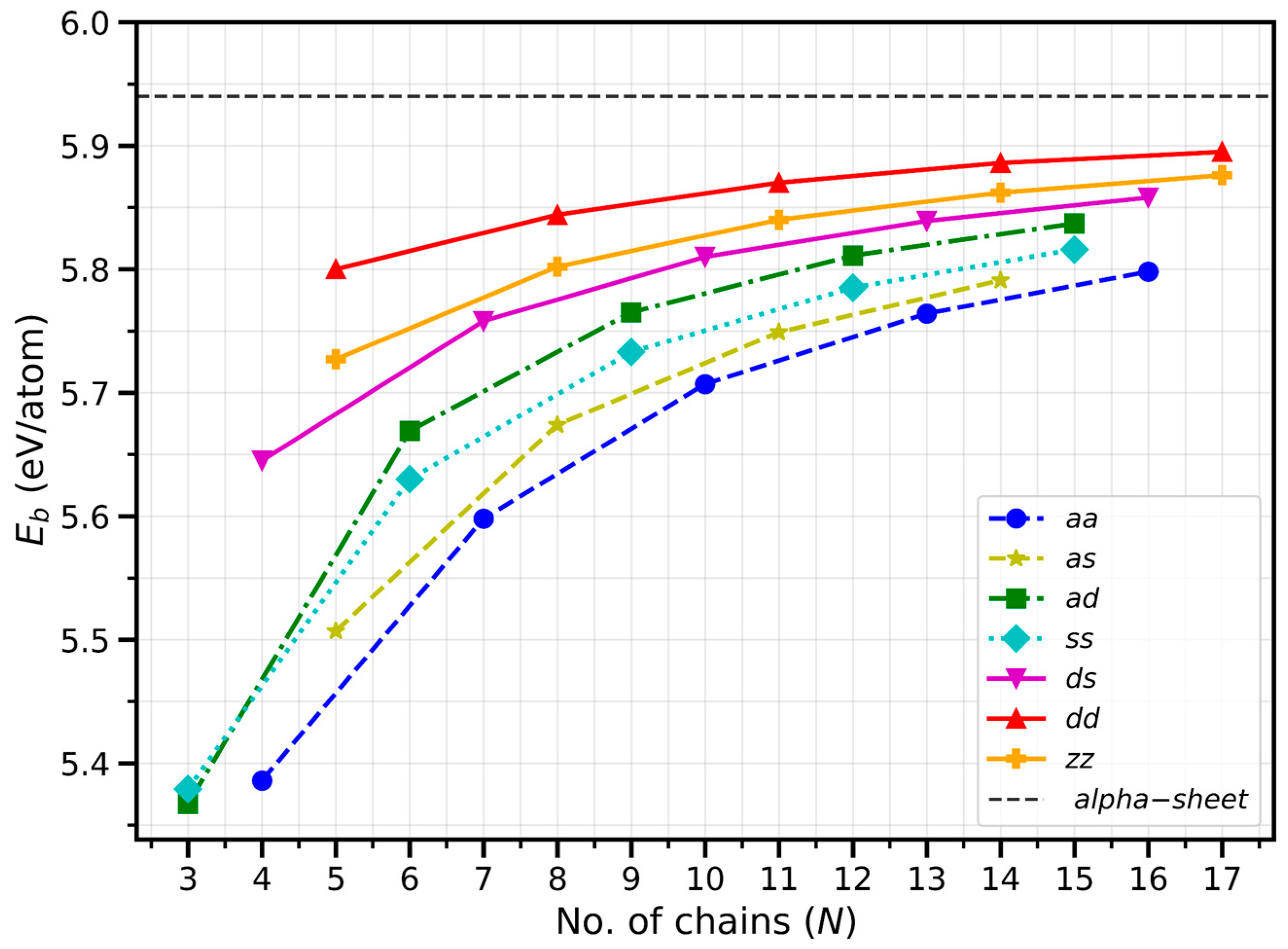

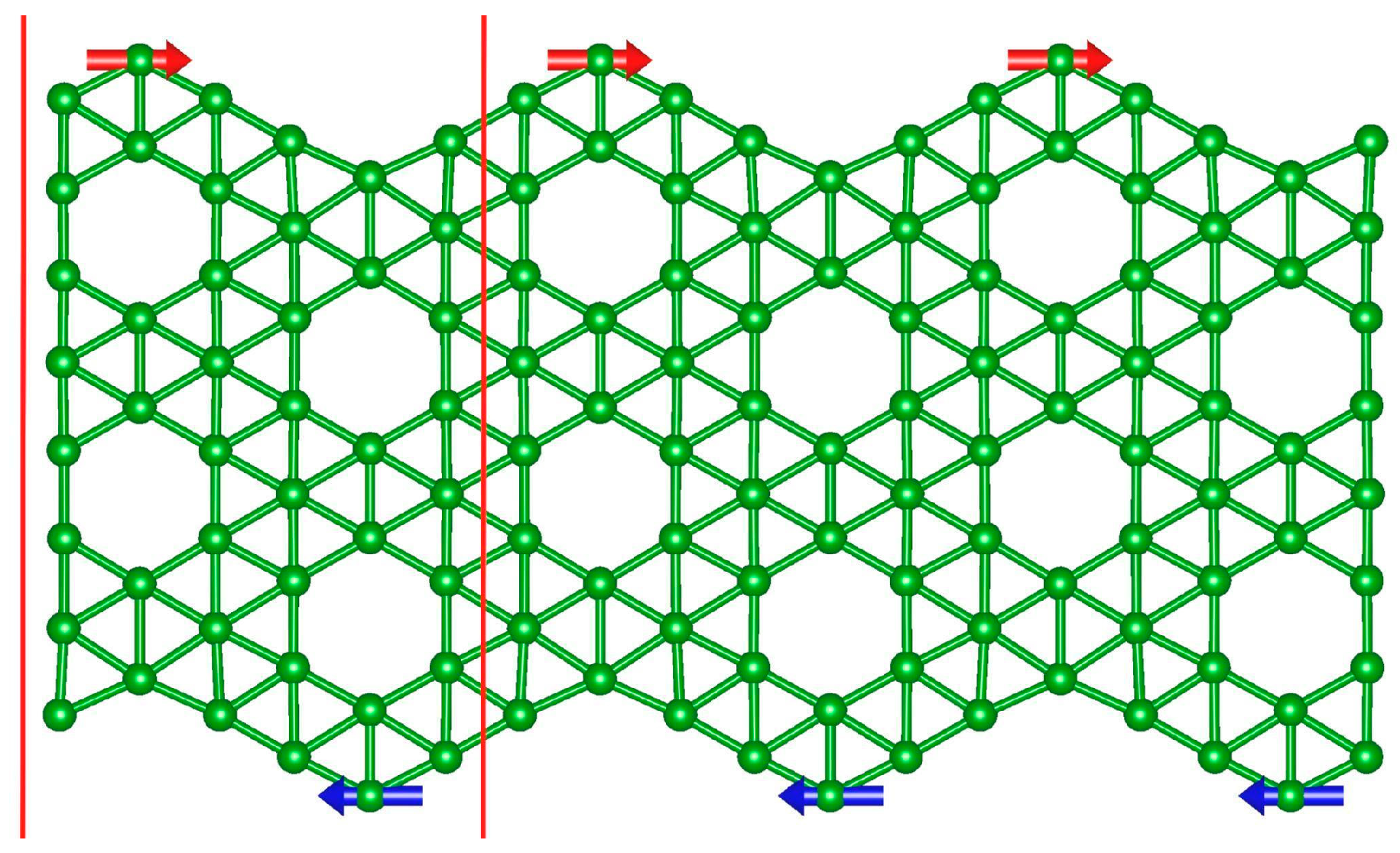
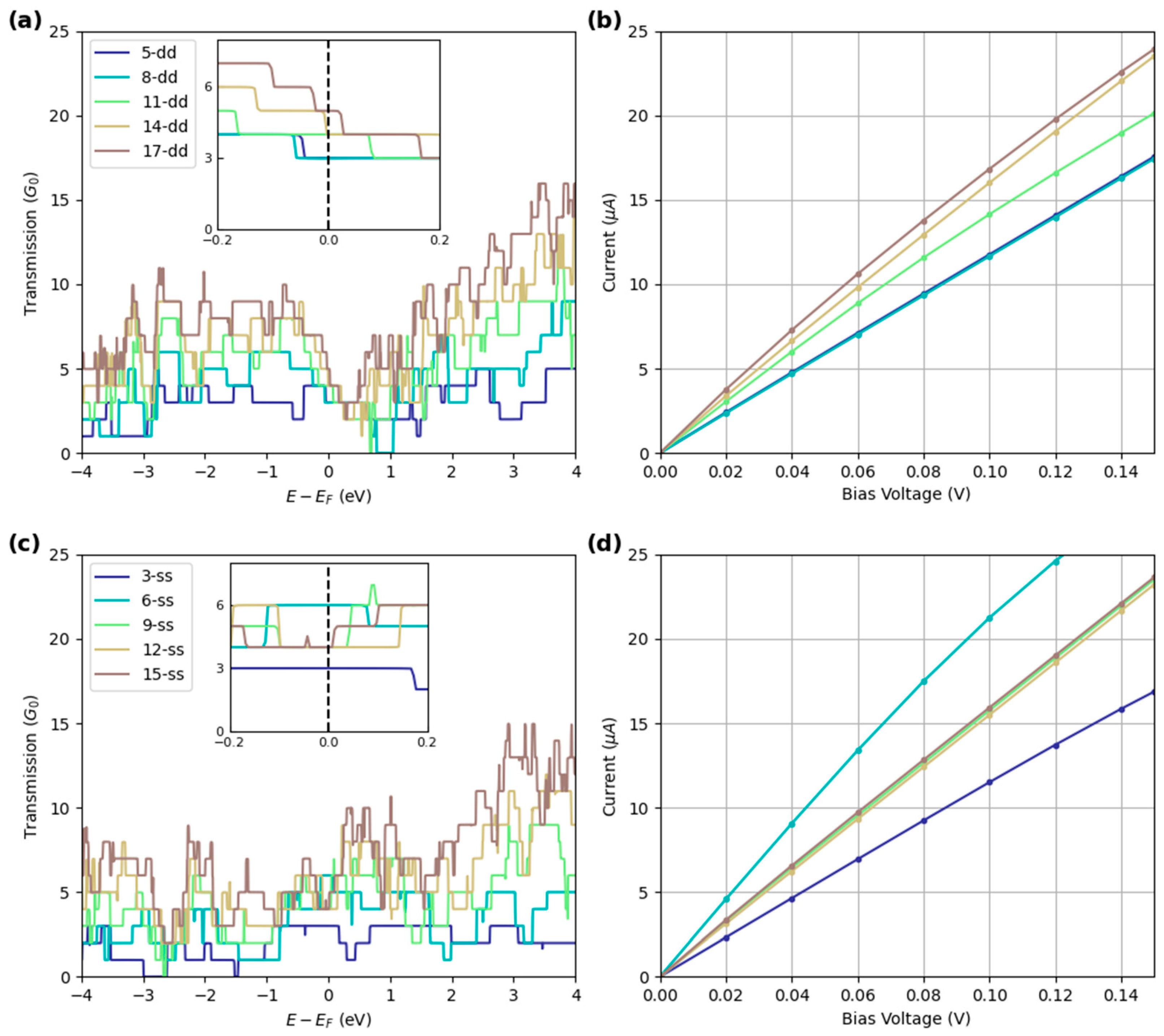
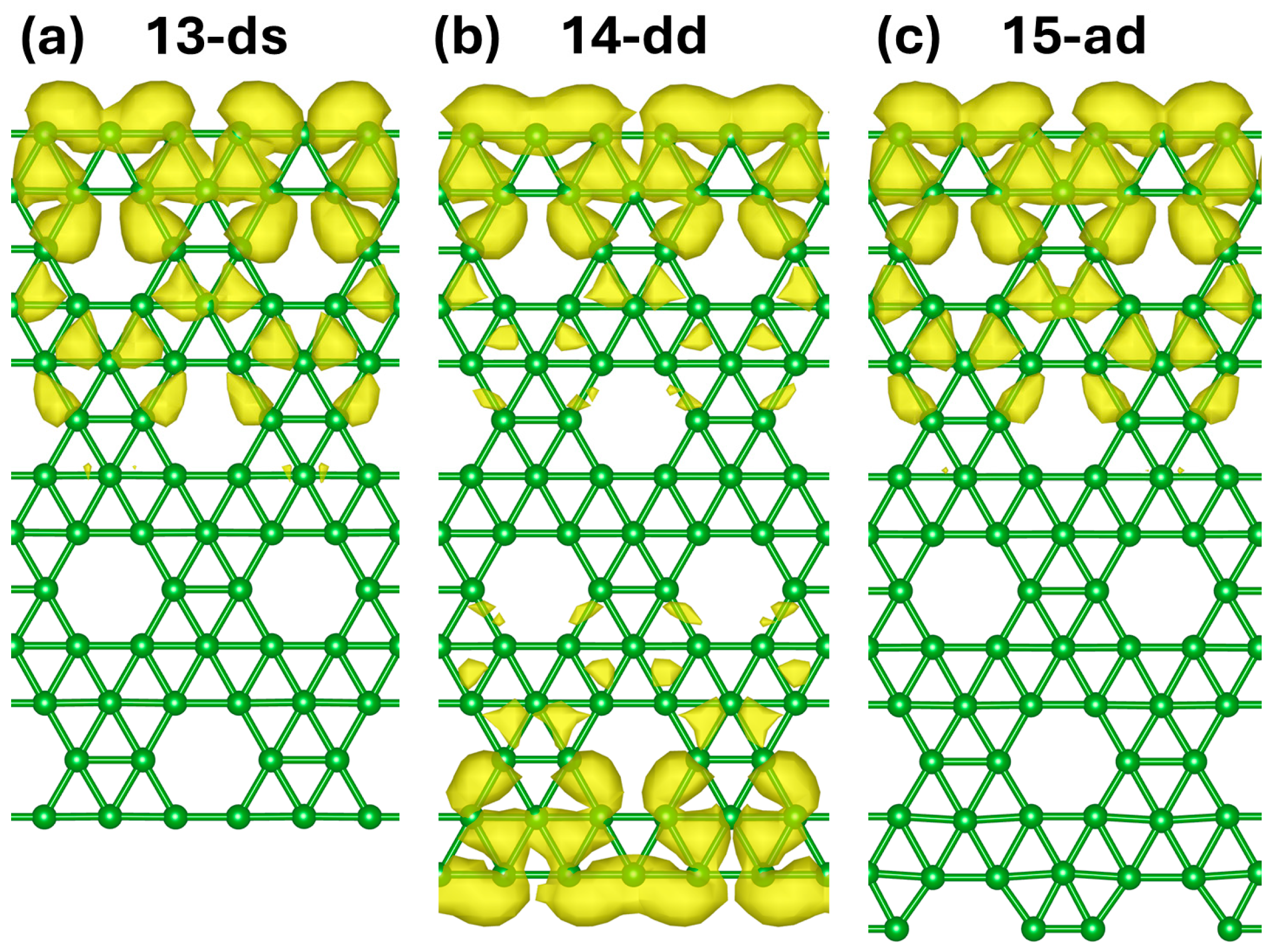
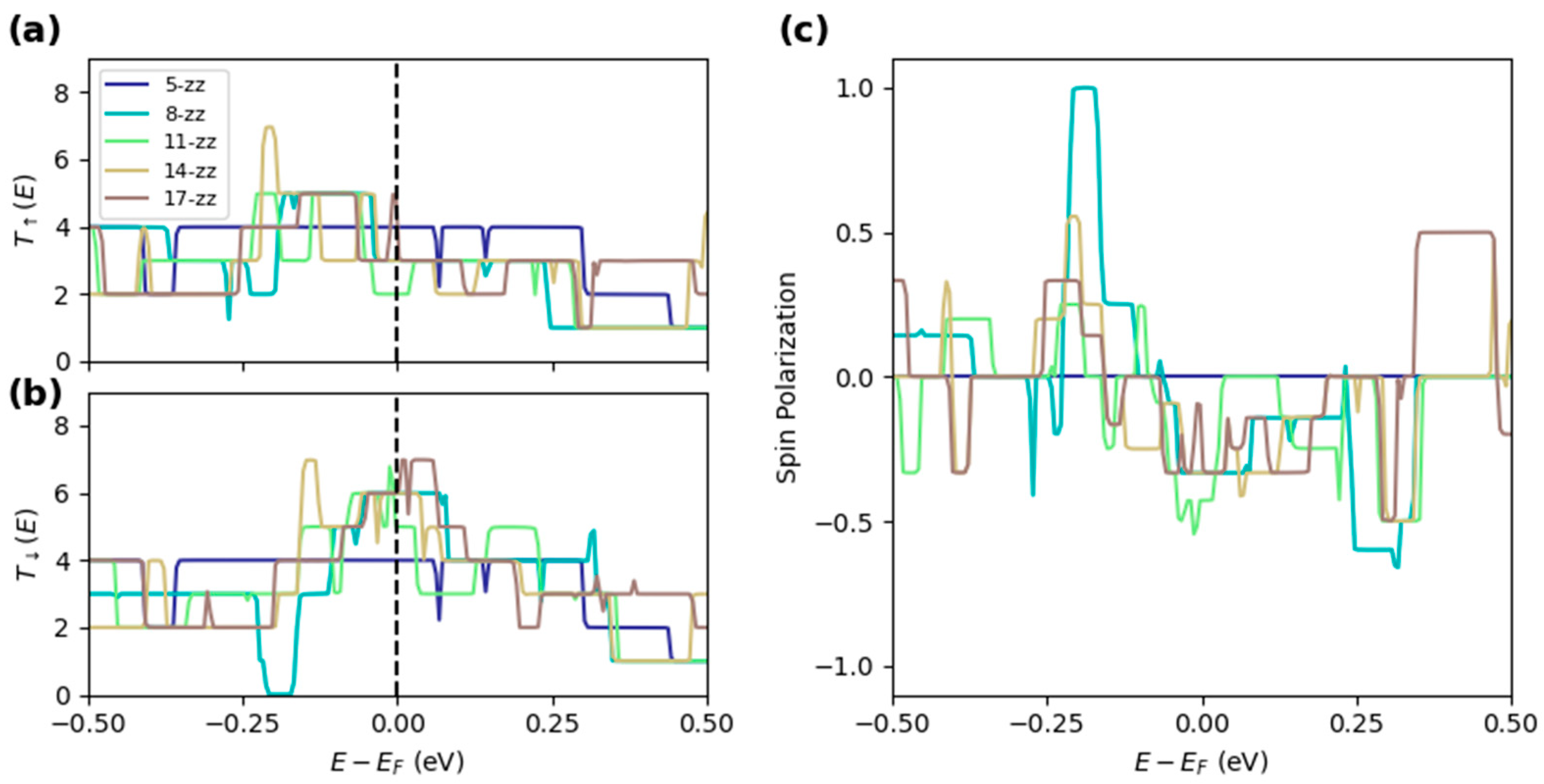
| Name | Width (Å) | (eV/atom) | ε (eV/Å) | dmin (Å) | dmax (Å) | M () | T (E = EF) (up/down) |
|---|---|---|---|---|---|---|---|
| 4-aa | 4.11 | 5.386 | 0.52 | 1.54 | 1.94 | 0.012 | 3 |
| 7-aa | 8.56 | 5.599 | 0.59 | 1.53 | 1.79 | 0.028 | 3 |
| 10-aa | 12.96 | 5.707 | 0.59 | 1.52 | 1.80 | 0.017 | 3 |
| 13-aa | 17.34 | 5.764 | 0.58 | 1.52 | 1.80 | 0.003 | 3 |
| 16-aa | 21.73 | 5.798 | 0.58 | 1.52 | 1.80 | 0.001 | 3 |
| 5-as | 5.79 | 5.507 | 0.56 | 1.51 | 1.79 | 0.019 | 4 |
| 8-as | 10.18 | 5.674 | 0.55 | 1.51 | 1.79 | 0.006 | 3 |
| 11-as | 14.55 | 5.749 | 0.55 | 1.51 | 1.79 | 0.004 | 3 |
| 14-as | 18.94 | 5.791 | 0.55 | 1.51 | 1.79 | 0.000 | 4 |
| 3-ad | 2.94 | 5.367 | 0.45 | 1.54 | 1.78 | 0.000 | 0 |
| 6-ad | 7.28 | 5.669 | 0.43 | 1.52 | 1.79 | 0.000 | 4 |
| 9-ad | 11.67 | 5.765 | 0.42 | 1.52 | 1.80 | 0.000 | 4 |
| 12-ad | 16.06 | 5.811 | 0.41 | 1.52 | 1.79 | 0.000 | 4 |
| 15-ad | 20.45 | 5.837 | 0.41 | 1.52 | 1.79 | 0.003 | 5 |
| 3-ss | 2.98 | 5.379 | 0.46 | 1.60 | 1.70 | 0.015 | 3 |
| 6-ss | 7.41 | 5.630 | 0.50 | 1.60 | 1.72 | 0.000 | 6 |
| 9-ss | 11.77 | 5.733 | 0.50 | 1.61 | 1.71 | 0.000 | 4 |
| 12-ss | 16.17 | 5.785 | 0.50 | 1.62 | 1.71 | 0.000 | 4 |
| 15-ss | 20.53 | 5.816 | 0.49 | 1.62 | 1.74 | 0.000 | 4 |
| 4-ds | 4.45 | 5.645 | 0.33 | 1.61 | 1.75 | 0.011 | 3 |
| 7-ds | 8.87 | 5.758 | 0.35 | 1.62 | 1.74 | 0.019 | 4 |
| 10-ds | 13.27 | 5.810 | 0.35 | 1.61 | 1.73 | 0.004 | 5 |
| 13-ds | 17.65 | 5.839 | 0.35 | 1.62 | 1.73 | 0.003 | 5 |
| 16-ds | 22.05 | 5.858 | 0.35 | 1.62 | 1.74 | 0.002 | 4 |
| 5-dd | 5.98 | 5.800 | 0.20 | 1.64 | 1.72 | 0.009 | 3 |
| 8-dd | 10.38 | 5.844 | 0.21 | 1.64 | 1.72 | 0.005 | 3 |
| 11-dd | 14.78 | 5.870 | 0.21 | 1.65 | 1.73 | 0.000 | 4 |
| 14-dd | 19.13 | 5.886 | 0.21 | 1.65 | 1.72 | 0.003 | 4 |
| 17-dd | 23.52 | 5.895 | 0.21 | 1.66 | 1.72 | 0.002 | 5 |
| 5-zz | 9.03 | 5.727 | 0.34 | 1.60 | 1.86 | 0.005 | 4 |
| 8-zz | 14.13 | 5.802 | 0.35 | 1.62 | 1.83 | 1.335 | 3/6 |
| 11-zz | 19.18 | 5.840 | 0.34 | 1.62 | 1.82 | 1.335 | 2/5 |
| 14-zz | 24.24 | 5.862 | 0.34 | 1.62 | 1.82 | 1.325 | 3/6 |
| 17-zz | 29.29 | 5.876 | 0.34 | 1.62 | 1.81 | 1.30 | 3/6 |
| Ef (eV/Å) | dB-X (Å) | M () | T (E = EF) (up/down) | |
|---|---|---|---|---|
| H-5-zz | −0.916 | 1.189 | 0.0 | 3 |
| H-8-zz | −0.931 | 1.189 | 0.0 | 5 |
| H-11-zz | −0.935 | 1.189 | 0.0 | 2 |
| H-14-zz | −0.936 | 1.189 | 0.0 | 2 |
| H-17-zz | −0.937 | 1.189 | 0.0 | 2 |
| O-5-zz | −1.342 | 1.283 | 0.855 | 3/5 |
| O-8-zz | −1.338 | 1.283 | 0.791 | 4/6 |
| O-11-zz | −1.349 | 1.283 | 0.845 | 6/4 |
| O-14-zz | −1.347 | 1.283 | 0.855 | 2/6 |
| O-17-zz | −1.345 | 1.283 | 0.87 | 2/6 |
| F-5-zz | −1.415 | 1.339 | 0.0 | 3 |
| F-8-zz | −1.428 | 1.339 | 0.0 | 4 |
| F-11-zz | −1.429 | 1.339 | 0.0 | 2 |
| F-14-zz | −1.428 | 1.339 | 0.0 | 2 |
| F-17-zz | −1.428 | 1.339 | 0.0 | 2 |
Disclaimer/Publisher’s Note: The statements, opinions and data contained in all publications are solely those of the individual author(s) and contributor(s) and not of MDPI and/or the editor(s). MDPI and/or the editor(s) disclaim responsibility for any injury to people or property resulting from any ideas, methods, instructions or products referred to in the content. |
© 2025 by the authors. Licensee MDPI, Basel, Switzerland. This article is an open access article distributed under the terms and conditions of the Creative Commons Attribution (CC BY) license (https://creativecommons.org/licenses/by/4.0/).
Share and Cite
Rakshit, S.; Sun, F.; Gonzalez Szwacki, N.; Yakobson, B.I. α-Borophene Nanoribbons: Edge-Dependent Metallic and Magnetic Properties for Low-Dimensional Nanoelectronics. Molecules 2025, 30, 4177. https://doi.org/10.3390/molecules30214177
Rakshit S, Sun F, Gonzalez Szwacki N, Yakobson BI. α-Borophene Nanoribbons: Edge-Dependent Metallic and Magnetic Properties for Low-Dimensional Nanoelectronics. Molecules. 2025; 30(21):4177. https://doi.org/10.3390/molecules30214177
Chicago/Turabian StyleRakshit, Subrata, Favian Sun, Nevill Gonzalez Szwacki, and Boris I. Yakobson. 2025. "α-Borophene Nanoribbons: Edge-Dependent Metallic and Magnetic Properties for Low-Dimensional Nanoelectronics" Molecules 30, no. 21: 4177. https://doi.org/10.3390/molecules30214177
APA StyleRakshit, S., Sun, F., Gonzalez Szwacki, N., & Yakobson, B. I. (2025). α-Borophene Nanoribbons: Edge-Dependent Metallic and Magnetic Properties for Low-Dimensional Nanoelectronics. Molecules, 30(21), 4177. https://doi.org/10.3390/molecules30214177







